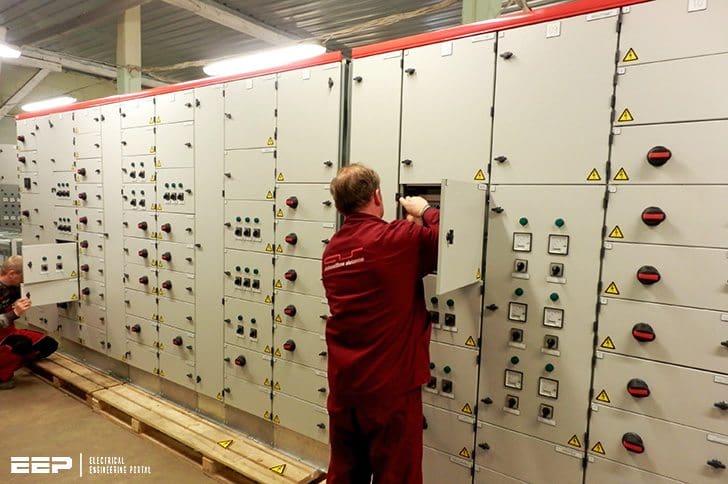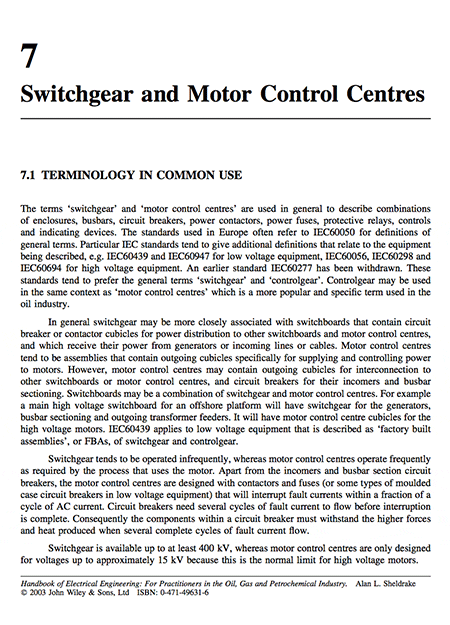Construction of Switchgear
The switchgear (SWGR) and motor control centres (MCC) considered in this section are those found in the onshore and offshore oil industry for supplying power to processes and utilities. Extra high voltage (EHV) transmission and distribution equipment used by electricity authorities is not considered herein.

Hence most of the equipment used onshore and offshore is limited to an upper service voltage of between 11 kV and 15 kV. Occasionally voltages in the range of 30 kV to 40 kV are used when the incoming line or generating capacity exceeds approximately 120 MW. Voltages as high as 69 kV are used for long submarine cable systems.
The construction is therefore of the metal clad type, in which all the live parts are housed in a mild-steel sheet metal enclosure. The enclosure is sub-divided so that personnel may work safely on some compartments without danger or the risk of electric shock.
Various degrees of personnel and ingress protection are commonly available.
The degree of protection is defined in various international standards e.g. NEMA and NEC in USA, IEC in UK and Europe.
For use inside buildings where manual operation and interference is infrequent and where the atmosphere is cool, dry and clean an enclosure of the IEC60529 type IP40, 41 or 42 or NEMA type 1 or 2 is usually adequate.
If equipment is to be located in a poor atmosphere e.g. dust laden, damp, hot and where hose-pipes may be used to wash down adjacent plant, then a more demanding enclosure type is required e.g. IP54 or NEMA type 4, but this would normally only apply to low voltage equipment.
The main electrical components are:
- Main busbars
- Earthing busbar
- Incoming and busbar section circuit breakers
- Outgoing switching devices, contactors or circuit breakers
- Fuses for MCC outgoing circuits.
- Safety interlocking devices.
- Electrical protective relays and devices for all power circuits.
- Control and indication devices.
- Communication or network interfacing system.
- Main connections and terminal compartments.
Switchgear tends to be operated infrequently, whereas motor control centres operate frequently as required by the process that uses the motor.
Circuit breakers need several cycles of fault current to flow before interruption is complete. Consequently the components within a circuit breaker must withstand the higher forces and heat produced when several complete cycles of fault current flow.
Switchgear is available up to at least 400 kV, whereas motor control centres are only designed for voltages up to approximately 15 kV because this is the normal limit for high voltage motors.
| Title: | Switchgear and Motor Control Centres – Handbook of Electrical Engineering: For Practitioners in the Oil, Gas and Petrochemical Industry by Alan L. Sheldrake |
| Format: | |
| Size: | 386 KB |
| Pages: | 30 |
| Download: | Right here | Video Courses | Membership | Download Updates |



I like your mails. It’s helps me since am in an aluminium smelter company
Hello am Bismark form Ghana
Thank you all for the great work you are doing to help improve the life of many
I am an electrician with seven years of experience in the electrical sector
It is my wise to know more about electricity to help improve the life of many in my country Ghana
I will be so grateful if you can help me to do that especially in earthing and earthing protective devices and how to reduce electrical shock
Hope to hear from you
Thank you
Though I am just getting to know EEP, your materials are good and helpful.
I am not an Electrical Engineer. A recruiter for overseas company. By reading this site I got a lot of information on electrical subject which help me to understand the requirement of client- thanks and regards for this great help
what is eep eex t5
I need to know about instrumentation engineering details related to oil,gas & petrochemical industry
I am reading EEP past one and half year.This portal is way of heaven and ocen of electrical technology to deserved electrical engineer.
I am very much thankful to EEP and their staff.